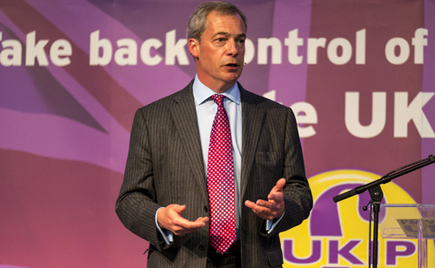Immigrants and insecure workers
 david muscroft / Shutterstock.com
david muscroft / Shutterstock.com
Donald Trump received a boost at a rally in Jackson, Mississippi, last week from the U.K. Independence Party’s Nigel Farage, a caustic prophet of British nationalism. It is a reminder that an angry, anti-immigrant populism has preoccupied both British and American politics this year, fueled by opportunistic politicians and uneasy blue-collar voters. According to both supporters and opponents of the United Kingdom’s exit from the European Union, animus toward immigration lay at the heart of the “Leave” vote. As former British Prime Minister Tony Blair laments, hard right leaders like Farage seized on immigration and “took this issue and focused its campaign to leave Europe on it.”
On this side of the Atlantic, of course, hostility toward immigration—especially unauthorized inflows—also played a key role in motivating the 13.3 million voters who backed Trump’s path to the Republican nomination. Even as unauthorized immigration from Mexico has dropped to its lowest level since 1971, Trump’s histrionics over building a wall on the U.S.-Mexico border and deporting millions of undocumented immigrants already have captivated many economically insecure white voters.
Nativist political entrepreneurs take advantage of low levels of information and lack of direct experience with immigrants among the voters whom they target. Survey data show that Americans who are least tolerant of immigration are those who have little or no personal contact with immigrants, in their workplaces, churches, schools, and neighborhoods. This finding is consistent with Brexit results showing that voters living in high-immigration areas such as London voted to remain in the EU.
Measuring the economic impacts of immigration on a receiving country’s population is complex. But the vast bulk of systematic research, in both the United States and United Kingdom, shows that the labor market consequences are far less than popularly believed. At least in the short term, international labor mobility, like other dimensions of globalization, produces winners and losers. It can negatively impact the wages of the lowest income-earners while raising the incomes of higher earners. But in both cases, the effects are very small.
And it is not at all clear that adversely impacted, native-born workers would be helped appreciably by adopting more restrictive immigration policies. We know from extensive research that direct immigrant-to-native competition for the same jobs, in the same industries, in the same regions is rare due to segmentation of the labor market over several generations. Very few native-born workers apply for jobs in immigrant-dominated firms. We also know that wage stagnation is driven far more by the decline of unionization, outsourcing, and technological change than by immigration.
Some people who support anti-immigrant candidates and movements undoubtedly view themselves as victims of “uncontrolled” immigration. But only a minority of such voters are low-skilled workers who personally experienced unemployment or depressed wages due to immigration. Many more seem to be responding to nativist appeals by entrepreneurial politicians, whose messages are amplified by both the mass media and social media. Their rhetoric demonizes immigrants by depicting all of them as burdens on the economy while ignoring the benefits of their presence to consumers, employers, and national economic performance.
The kind of immigration debates now raging on both sides of the Atlantic deflect attention from policies that might actually improve the lives of those who see themselves as victims of immigration. For example, Britain lacks an effective national program to train native-born workers for construction jobs. Thus, Polish workers arrive better-trained for such jobs, and—not surprisingly—employers prefer to hire them. In the United States, stagnant wages and income inequality could be addressed much more efficiently through investments in education, job training, child care, housing, and minimum wage enforcement than with an immigration crackdown. Both the United States and Britain have failed to provide enough targeted assistance to workers and communities negatively impacted by globalized production.
Can such policy nuances be communicated effectively in the heat of a national political campaign? The Brexit campaign suggests how difficult it is. “Leave” voters had multiple grievances against the EU, including excessive regulation from unelected bureaucrats in Brussels. “Remain” politicians did a poor job of addressing concerns about free movement of labor from other EU countries, in terms of its scale, pace of increase, and impacts on public services. The “Leave” campaign drowned them out with the simple message that immigration was “out of control” and causing profound problems.
In the United States, a strong case can be made that an immigration debate focused on how best to achieve comprehensive reform of the nation’s immigration system, including a path to legalization for the 11 million undocumented immigrants living in the country, is essential. Comprehensive reform could help to neutralize anxiety over porous borders, reduce the short-term costs of immigration (especially to low-skilled Americans), and maximize its long-term social and economic benefits. But debate over comprehensive reform and other potentially beneficial policies is currently being held hostage by an electoral process driven by populist anger, stoked by political demagogues focused narrowly on garnering votes.
Wayne A. Cornelius is director emeritus of the Mexican Migration Field Research Program at the University of California, San Diego. Daniel Tichenor is the Philip H. Knight Professor of Social Science and Senior Scholar at the Wayne Morse Center for Law and Politics at the University of Oregon.